Introduction
This introduction aims to teach new players the basics of Company of Heroes. It briefly touches upon subjects such as victory conditions, resources, teching, the suppression system and other core mechanics of the game. By the end of this guide you should have a grasp of the workings of Company of Heroes; it will allow you to easily find your feet in your first Company of Heroes game, as well as comfortably follow any show or livestream.
Victory Conditions
First things first: how do you win a match?
Company of Heroes has two game modes: Annihilation and Victory Point Control.
In Annihilation you win by simply destroying your opponent's base.
In Victory Point Control the game focuses around several Victory Points located on the map. Both sides start with the same number of 'Victory Point tickets'. If you hold more Victory Points than the opponent then the opponent's tickets start decreasing and when a player has no tickets left, he loses. The Annihilation victory condition also applies in this mode so if you destroy the opponent's base you will also win.
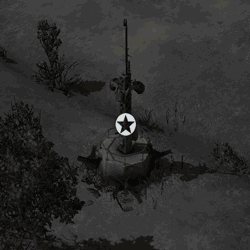
Victory Point Control is the only mode played competitively and the only mode available in ranked matchmaking. Matches tend to drag on without Victory Points to end them and the factions are balanced with this particular game mode in mind.
Company of Heroes has two game modes: Annihilation and Victory Point Control.
Annihilation
In Annihilation you win by simply destroying your opponent's base.
Victory Point Control
In Victory Point Control the game focuses around several Victory Points located on the map. Both sides start with the same number of 'Victory Point tickets'. If you hold more Victory Points than the opponent then the opponent's tickets start decreasing and when a player has no tickets left, he loses. The Annihilation victory condition also applies in this mode so if you destroy the opponent's base you will also win.
An example of Victory Point. The icon is grey when neutral, and turns blue when you hold it. Notice how little Line-of-Sight it provides when owned.
Victory Point Control is the only mode played competitively and the only mode available in ranked matchmaking. Matches tend to drag on without Victory Points to end them and the factions are balanced with this particular game mode in mind.
Resources
There are three main types of resources in Company of Heroes:
Your army size is governed by your population cap:
In Company of Heroes you receive resources by holding parts of the map. The map is divided into sectors that you can seize by capturing the strategic point inside them. Generally speaking only infantry units can capture strategic points.
Resources accumulate when sectors have been captured and are connected to your base sector via other sectors. Think of it as of a supply line: by capturing a strategic point in between, the supply line can be broken and the isolated sectors no longer give any resources. Captured sectors are coloured blue on the minimap, enemy sectors are red and neutral sectors are grey. Isolated sectors will flash on the mini-map as shown below.
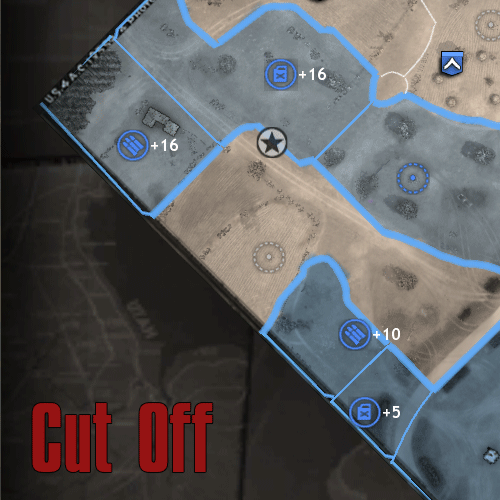
As you can see, not every sector gives the same amount of resources. High resource points can give the player that holds them a significant advantage and they are often an objective of fights and pushes. High resource sectors are no less important than Victory Points!
Manpower is the main resource in the game. Every unit costs manpower to purchase, it is used when constructing buildings and purchasing global upgrades. As such, its income is almost an order of magnitude greater than of fuel or munitions. Unlike the other resources, most of the manpower is earned through the base sector and the HQ. This income is therefore guaranteed. The base sector holds no strategic point and cannot be captured by the opponent. Holding sectors outside of the base increases manpower income marginally.
There is an upkeep cost for every unit on the field: every single man you build slightly reduces manpower income. This is called upkeep. There are no other additional costs involved in keeping units going and fighting, for example, a vehicle doesn't burn fuel as it drives around.
Fuel is the main limiting resource to how fast you can tech up to more powerful units, such as vehicles and tanks. New buildings, vehicles, and global unit upgrades cost fuel, so denying your opponent this valuable resource is often a deciding factor in the game.
Note: the HQ also provides a +5 fuel income.
Munitions are used for powerful special abilities, such as throwing a grenade, or ordering a Strafing Run. They are also used in upgrading individual units with more advanced weaponry.
Population cap is different from the other resources in the sense that it does not accumulate over time. Captured and connected sectors increase your population cap in the original Company of Heroes. Every unit on the field takes up population cap; if you reach the cap, you can no longer build new units. If you lose control over a sector the population cap decreases again. Therefore, cutting off your opponent from his sectors not only denies him some of his resource income but can also limit the size of his army. In Company of Heroes 2, each army has a fixed population cap of 100.
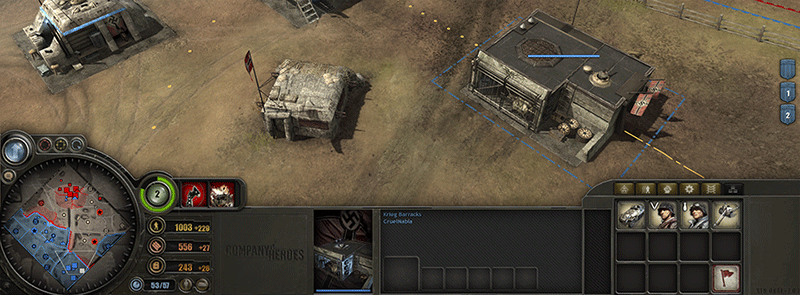
- [img="http://www.coh2.org/file/554/coh_resource_icon_manpower.png" alt=""][/img][img="http://www.coh2.org/file/554/coh_resource_icon_manpower.png" alt=""][/img] Manpower
 Fuel
Fuel
 Munitions
Munitions
Your army size is governed by your population cap:
 Population cap
Population cap
In Company of Heroes you receive resources by holding parts of the map. The map is divided into sectors that you can seize by capturing the strategic point inside them. Generally speaking only infantry units can capture strategic points.
Resources accumulate when sectors have been captured and are connected to your base sector via other sectors. Think of it as of a supply line: by capturing a strategic point in between, the supply line can be broken and the isolated sectors no longer give any resources. Captured sectors are coloured blue on the minimap, enemy sectors are red and neutral sectors are grey. Isolated sectors will flash on the mini-map as shown below.

As you can see, not every sector gives the same amount of resources. High resource points can give the player that holds them a significant advantage and they are often an objective of fights and pushes. High resource sectors are no less important than Victory Points!
Manpower
Manpower is the main resource in the game. Every unit costs manpower to purchase, it is used when constructing buildings and purchasing global upgrades. As such, its income is almost an order of magnitude greater than of fuel or munitions. Unlike the other resources, most of the manpower is earned through the base sector and the HQ. This income is therefore guaranteed. The base sector holds no strategic point and cannot be captured by the opponent. Holding sectors outside of the base increases manpower income marginally.
There is an upkeep cost for every unit on the field: every single man you build slightly reduces manpower income. This is called upkeep. There are no other additional costs involved in keeping units going and fighting, for example, a vehicle doesn't burn fuel as it drives around.
Fuel
Fuel is the main limiting resource to how fast you can tech up to more powerful units, such as vehicles and tanks. New buildings, vehicles, and global unit upgrades cost fuel, so denying your opponent this valuable resource is often a deciding factor in the game.
Note: the HQ also provides a +5 fuel income.
Munitions
Munitions are used for powerful special abilities, such as throwing a grenade, or ordering a Strafing Run. They are also used in upgrading individual units with more advanced weaponry.
Population cap
Population cap is different from the other resources in the sense that it does not accumulate over time. Captured and connected sectors increase your population cap in the original Company of Heroes. Every unit on the field takes up population cap; if you reach the cap, you can no longer build new units. If you lose control over a sector the population cap decreases again. Therefore, cutting off your opponent from his sectors not only denies him some of his resource income but can also limit the size of his army. In Company of Heroes 2, each army has a fixed population cap of 100.

Note how you cannot build units when the population cap is reached.
Base Buildings and Teching
In Company of Heroes teching primarly takes place through base building construction. The tech tree works through 'tiers', although it differs for each faction. A tier is defined as a tech level the player is at and indicates what units, buildings and upgrades are available to them. Higher tiers come further down the tech tree and bring more potent units.
Every player starts with a Headquarters building in their base sector, which allows for the construction of the basic builder unit. The first tier generally enables construction of basic infantry, the second tier infantry support weapons, while the third and fourth tier bring combat vehicles and tanks.
Contrary to most RTSs, the base is protected by two machine gun emplacements. For that reason scouting your opponent's tech path by taking a look into their base is much more difficult.
Every player starts with a Headquarters building in their base sector, which allows for the construction of the basic builder unit. The first tier generally enables construction of basic infantry, the second tier infantry support weapons, while the third and fourth tier bring combat vehicles and tanks.
Contrary to most RTSs, the base is protected by two machine gun emplacements. For that reason scouting your opponent's tech path by taking a look into their base is much more difficult.
Doctrines / Commanders
In Company of Heroes each faction has access to 3 different doctrines. Every doctrine is divided into two trees. You progress in these trees by spending command points. Command points obtained by earning experience.
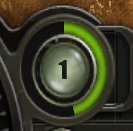
You receive experience for killing or losing units, as well as building or destroying structures. Earned experience is displayed by floating green numbers as shown below. You can choose your doctrine throughout a game but you are not allowed to change it.
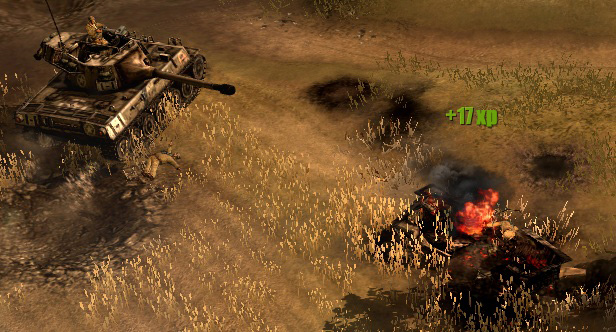
Doctrines give access to more and more powerful units and abilities as you spend more command points. Among those are off map artillery strikes, active and passive unit upgrades, as well as the mighty King Tiger.
All doctrines are different and it is very important to choose your doctrine wisely so it fits into your game plan. For example, if you plan on heavily relying on infantry you might want to choose the Infantry doctrine, whereas the Armour doctrine would better suit a tank enthusiast. It is important to note that some doctrines can counter other doctrines, that is why waiting to see your opponent's doctrine before choosing yours can be very rewarding.
In Company of Heroes 2, a variety of Commanders are available, with additional commanders sold by Relic as DLC. They function similar to Doctrines, unlocking call-in units and off-map abilities as your Command Points increase.

This is the part of the HUD that displays the amount of command points at your disposal. The green bar shows how much experience you need to unlock the next command point.
You receive experience for killing or losing units, as well as building or destroying structures. Earned experience is displayed by floating green numbers as shown below. You can choose your doctrine throughout a game but you are not allowed to change it.

Doctrines give access to more and more powerful units and abilities as you spend more command points. Among those are off map artillery strikes, active and passive unit upgrades, as well as the mighty King Tiger.
All doctrines are different and it is very important to choose your doctrine wisely so it fits into your game plan. For example, if you plan on heavily relying on infantry you might want to choose the Infantry doctrine, whereas the Armour doctrine would better suit a tank enthusiast. It is important to note that some doctrines can counter other doctrines, that is why waiting to see your opponent's doctrine before choosing yours can be very rewarding.
In Company of Heroes 2, a variety of Commanders are available, with additional commanders sold by Relic as DLC. They function similar to Doctrines, unlocking call-in units and off-map abilities as your Command Points increase.
Conclusion
Now you now know the basics of Company of Heroes! Do you feel ready to go take on your first opponent? You shouldn't, as there are some more advanced mechanics to know, such as the combat system. Unless you are remotely related to Gandhi and know how to win without fighting, I highly recommend reading the second part of this guide, coming out soon!


